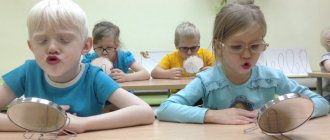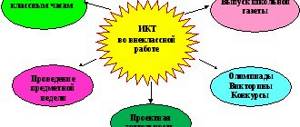"Russian song"
Tchaikovsky had strict requirements for the processing of a folk song: “It is necessary that the song be recorded, as far as possible, in accordance with how the people perform it.”
So in “Russian Song” the composer turned to the Russian folk dance song “Are you a head, my head?”
Throw a flower into a stream - the stream will carry it away. Sing me a nightingale song - It will make my heart happier.
"A man plays the harmonica"
In the play “A Man Plays the Harmonica,” the intonation turns and harmonic moves characteristic of Russian single-row harmonicas are played out.
"Kamarinskaya"
“Kamarinskaya” is based on one of the variants of the famous Russian folklore theme and imitates the balalaika tune.
How much fun we have today - everyone started dancing to Kamarinskaya. Mom dances, dad dances, I dance, my sisters dance, my whole family dances. Grandma is dancing, grandfather is dancing, brother and neighbor are dancing
“Italian”, “Old French”, “German” and “Neapolitan” songs are a kind of “pages from a traveler’s diary”: their melodies were recorded by the composer during a trip abroad in 1878.
"Homecoming".
"Nanny's Tale"
Then it’s time to go to sleep, and the image of a grandmother with her fairy tales and dreams appears before us.
"Baba Yaga"
From the caustic chords of “Nanny’s Tale” the nightmare of “Baba Yaga” seems to grow.
"Sweet Dream"
A terrible dream is replaced by a sweetly sensual “Sweet Dream”
Peace of mind comes in the last three plays, the final microcycle of the Album.
"The Lark's Song"
It opens with “The Lark’s Song” - morning, the end of nightmares and languid dreams. This is a musical landscape with the image of a lovely bird and its unforgettable trills.
"The Organ Grinder Sings"
It is replaced by the play “The Organ Grinder Sings.” This play is a genre-characteristic sketch, the sounds of which depict an old man. He turns the handle of the organ and beautiful drawn-out sounds pour out of it. The play “The Organ Grinder Sings” is based on another Italian (Venetian) motif. A simple, but wisely calm theme dispels the child’s gloomy thoughts.
Songs of distant lands
The following storyline is represented by “Old French Song”, “German Song”, “Italian Song”. Each of the plays reflects the characteristics of folk music of these countries. It is known that Pyotr Ilyich traveled a lot, and he embodied his impressions in music. So you and I will take a fascinating musical journey and try to understand the characteristics of folk music and the flavor of these countries.
German song
The "German Song" from the "Children's Album" is reminiscent of the sound of a barrel organ and is very similar to the old German Lander dance, which was danced by peasants, with whirling and stomping in their wooden shoes
Neapolitan song
“The Neapolitan Song” is one of the most popular and brightest pieces of the “Children's Album”, reflecting the cheerful Italian carnival. Based on this play, Pyotr Ilyich created the “Neapolitan dance for the ballet “Swan Lake”.
Tchaikovsky's music, like Pushkin's poetry, comes to us in childhood and remains with us for life. Peter Ilyich left us a wonderful musical heritage - this is our culture, this is our art, without which there cannot be a worthy future.
P.I. Tchaikovsky "Children's Album"
It is known that Pyotr Ilyich Tchaikovsky loved children very much and understood them well. This is evidenced by his famous phrase that flowers, music and children constitute the best decoration of life. It is not surprising that the children's theme literally permeates all of his work, and the collection of plays “Children's Album” was the first such work in Russia. Later, this cycle was included in the golden fund of essays written specifically for children. This is not just a collection - it is a whole world, a magical country, retold in sounds.
the history of the creation of "Children's Album" , the contents of the work and many interesting facts on our page.
History of creation
Tchaikovsky was inspired by two factors to write a collection of short plays specifically for children. Firstly, they were inspired by the example of Robert Schumann . Pyotr Ilyich also wanted to compose a cycle of simple plays, like “ Album for Youth ,” that children could freely perform. Secondly, Tchaikovsky was prompted to the idea of composing such a work by communication with his nephews. It is known that the composer treated his sister’s children very warmly, often visited them, told different stories about his travels, played for them, and also listened with interest to all their stories.
Tchaikovsky first mentioned his intention to compose a collection of children's plays on February 26, 1878, in a letter to his publisher while in Florence. A month later, the composer begins work on the cycle. On April 30, 1878, during a visit to his sister A.I. Davydova in Kamenka, he writes to P.I. Jurgenson, reporting on his work on the “Children's Album”.
There is no information about the process of composing the cycle; it is known that the composer wrote it quite quickly. About a month later, in his letter to N.F. von Meck Pyotr Ilyich wrote that he had composed all the plays and now it would take another month and a half to put the cycle in order and edit everything.
On June 29, in his letter to the publisher, Tchaikovsky sent the manuscripts of all the works written at that time, including a collection of children's plays.
Researchers suggest that the idea of dedicating the collection to his nephew Volodya Davyvod came to Tchaikovsky after finishing work on the composition. It is known that in the summer of 1878 the composer spent a lot of time with him in Kamenka. There is no dedication in the autograph of the collection, but in his letter to N.F. von Meck Tchaikovsky already talks in detail about the fact that he decided to dedicate the cycle to his nephew, who loves music very much and even promises to become a musician. It is obvious that Tchaikovsky expressed his decision to the publisher during a personal meeting at the end of September, beginning of October 1878.
Interesting Facts
- It is known that Tchaikovsky received 240 rubles from the publishing house for his composition. This is exactly the price the composer himself set – 10 rubles for each piece.
- There is another factor that influenced Tchaikovsky’s decision to compose “Children’s Album” - his communication with Kolya Conradi (a pupil of the composer’s brother). It is known that with Kolya and M.P. He spent part of the winter of 1877-1878 with Tchaikovsky. They visited sights together and traveled a lot.
- Researchers believe that the reason that prompted the composer to start writing a collection of children's plays could be the very vivid impressions of hearing the song of a street singer in Florence. Tchaikovsky even wrote about this incident in a letter to his brother on March 27, 1878. The composer was especially shocked by the performance of such a “non-childish” song by a boy singer, which in his interpretation did not sound as tragic as in the original.
- Initially, Tchaikovsky conceived a slightly different order of the plays, which was changed already in the first edition, carried out with his participation.
- Despite the fact that the collection was originally intended specifically for children, it has firmly entered the world's musical literature and is often performed even by professional artists. Suffice it to recall the version of Ya.V. Fliera, which is familiar to many thanks to surviving audio recordings. The versions by M. Pletnev and V. Postnikova are highly artistic examples. Pletnev brings his own vision to the reading of this work. He changes the order of the numbers, putting forward his own version of the dramatic concept of the collection.
- Pyotr Ilyich highly appreciated the first edition of his collection, but he still did not like some aspects. Thus, he regretted the appearance of the “Children’s Album”. He wanted the format of the collection to be different, since Volodya (to whom the composition is dedicated) would be very uncomfortable looking at the notes when playing. The composer also had complaints about the illustrations.
- In all editions of the Soviet period, the title of the last play, “In the Church,” was specially changed to “Chorus.”
- It is interesting that the idea of creating similar collections of miniatures for children was later addressed by such composers as A.S. Arensky, V.I. Rebikov, S.M. Maykapar.
- There are a large number of arrangements of Tchaikovsky's children's collection for a variety of instruments and even orchestras. For example, Vladimir Milman and Vladimir Spivakov made an arrangement for chamber orchestra. Thanks to the efforts of Robert Groslot, an arrangement for chamber orchestra and wind ensemble appeared. There is a score for “Children’s Album” for a percussion ensemble, which was reworked by Anatoly Ivanov, and a little later, in 2014, an arrangement for string orchestra and percussion instruments appeared, made by composer Dmitry Batin.
Contents of the "Children's Album"
The “Children's Album” includes 24 plays with their own individual titles. The program content of the collection is structured in a certain sequence: morning, afternoon and evening. In addition, the cycle contains several storylines at once.
The first storyline reveals to the listeners images of a child waking up and the beginning of the day.
“Morning Prayer” is an incredibly beautiful, bright, contemplative play that evokes thoughts about God and the soul. Tchaikovsky managed to amazingly convey the singing of a choir in piano music. The melody of this piece seems to be woven from living intonations, thanks to its special presentation. The mood of concentration is also conveyed by uniform rhythmic movement, texture of presentation, simple harmonic language and light tonality.
The second play, “Winter Morning,” brings a different mood to the peaceful morning atmosphere. Inclement weather (cold, with blizzards and blizzards) is very accurately conveyed by the alarming and transparently enlightened music that replaces it. The middle part introduces a certain shade of sadness, which further sets off the onset of the reprise.
“Winter Morning” (listen)
The third play, “The Game of Horses,” opens the storyline of toys and the children's room. This short piece conveys the clatter of hooves very accurately thanks to a uniform rhythmic pulsation that brings it closer to a toccata. The image of toy horses helps convey the three-part meter, which in this case sounds light and lively.
In the play “Mama” the music is very simple, but full of emotional experiences. It is presented in the form of a duet: the lower voice has a warmer timbre, and the upper one has a clear, light timbre. In general, this piece is very harmonious, soft, even the composer chose the size not by chance, since the three-part structure gives the music roundness and softness.
In the play “March of the Wooden Soldiers,” Tchaikovsky reveals the main image with a very clear rhythmic pattern and precise strokes. The composer managed to very accurately convey the clear, almost mechanical movements of the soldiers to the beat of the drummer.
“March of the Wooden Soldiers” (listen)
The following plays (6,7,8,9), forming a small suite, reveal another storyline, which tells about the complex, serious mental life of a small child, who feels everything as keenly as adults.
“The Doll’s Disease” introduces a completely different figurative structure. Sad music conveys the experiences of a little girl who is so overplayed that she takes everything seriously and is very worried about her favorite doll. The musical fabric of the play is interestingly constructed, in which there is no continuous melody. Pauses, as well as plaintive intonations, convey the “sighs” and “moans” of the doll. After a tense climax, everything ends with a "fading" coda.
The play “Funeral of a Doll” has another subtitle, which was given by the author himself - “In imitation of Schumann.” In its figurative structure, this miniature is very similar to Robert Schumann’s “First Loss” from his “Album for Youth.” The composer took the child’s experiences very seriously, reflecting the little heroine’s genuine feelings.
“Waltz” quite suddenly bursts into the flow of the narrative, replacing sadness and sadness with fun. Why waltz? This dance was one of the most popular and beloved in the 19th century and it was performed not only at magnificent balls, but also at home celebrations. “Waltz” from “Children’s Album” conveys the atmosphere of a home holiday.
"Waltz" (listen)
“New Doll” is a continuation of the fun, because the girl is very happy with her new toy. She dances and spins with the new doll. The music very accurately conveys the mood of the little girl, the feeling of delight and joy. The piece resembles a waltz, however, it sounds very fast, the usual 3/4 time signature is doubled in speed.
The fast-paced Polish dance “Mazurka” continues the line of dance miniatures in the collection. But in Tchaikovsky it is more intimate in nature, which is why the first theme of the play is calm and elegiac.
The next three pieces of the “Children's Album” (11,12, 13) reveal the folk line and can even be called a kind of “Russian suite”.
All three plays: “Russian Song” , “A Man Playing a Harmonica” , “Kamarinskaya” convey national flavor and in them Tchaikovsky uses the same development technique - variation, which was characteristic of folk performance.
“Kamarinskaya” (listen)
The Russian theme is replaced by the Czech folk dance “Polka” . It sounds very cheerful, perky and elegant. Interestingly, this particular miniature is the most popular of the entire series.
In the next storyline, the composer presented songs from different countries. The theme of travel was very close to Tchaikovsky, because he visited quite a lot of countries and cities. It is obvious that he tried to translate all his impressions from numerous trips into music. This storyline includes plays 15,16,17,18 and number 23 is also adjacent to them. All these numbers are bright, colorful sketches. In them, Tchaikovsky very accurately conveyed Italian, French and German features in music.
It is no coincidence that the author gives preference to Italian ones, because he spends the autumn and winter of 1877-1878 traveling through European cities, in particular, Tchaikovsky visits Italy. From Milan he writes to N.F. von Meck about his vivid impressions received there.
It is curious that “Italian Song” , “German Song” , “The Organ Grinder Sings” and even, in a sense, “Old French Song” are united by one idea. They all resemble the sound of a barrel organ. The maestro retained these impressions from his childhood, when his father brought a mechanical organ from St. Petersburg. Thanks to this device, Tchaikovsky was able to get acquainted with the works of great composers.
“Italian song” (listen)
The “Children's Album” is not without fairy tales; there are two of them, and together with the play “Sweet Dream” they form a fairy-tale-dreamy line.
“Nanny's Tale” is a scary story told by an old nanny. The fairy-tale image revealed in the play is expressed using harmonic language and musical expressive means. Overall the music sounds very wary.
“Baba Yaga” is another fairy tale in the cycle in which the composer very accurately conveyed the fantastic flight of the main character. The sorceress quickly rushes past the audience. The music sounds sharp, with the characteristic “screams” of Baba Yaga and the “whistle of the wind.” With the help of musical expressive means, Tchaikovsky managed to very accurately characterize this fairy-tale character.
"Baba Yaga" (listen)
The play “Sweet Dream” has a calm, dreamy character. The softness of this miniature is emphasized by the harsh sound of the previous fairy-tale numbers.
“Sweet Dream” (listen)
“Song of the Lark” is a bright and incredibly picturesque picture that conveys the chirping of birds. The music sounds very easy, this is facilitated by the absence of rhythmic accents, as well as the fact that the motives of the melody begin and end mainly on weak beats.
The final play of the cycle “In the Church” is again an appeal to prayer, as in the first miniature. The music sounds quite strict and serious. This is due to the fact that the maestro used the authentic melody of prayer in it. Most likely, Tchaikovsky deliberately did not simplify the musical language, embodying the entire depth of feelings in such a rather small structure.
" Children's Album " is not only a collection of children's plays dedicated to his beloved nephew. This is a kaleidoscope of vivid images, a whole series of living impressions of the composer himself, which he was able to so accurately convey in music, as well as children’s emotions. This is an amazing work in its design and implementation, which is deservedly included in the golden fund of world musical literature for children.
Did you like the page? Share with your friends:
come back
Video: listen to Tchaikovsky’s “Children’s Album”
"Children's Album" by Tchaikovsky. Content
The “Children's Album” includes the following plays:
- Morning prayer
- Winter morning
- Mother
- Horse game
- March of the Wooden Soldiers
- Doll disease
- Doll funeral
- Waltz
- New doll
- Mazurka
- Russian song
- A man plays the harmonica
- Kamarinskaya
- Polka
- Italian song
- An old French song
- German song
- Neapolitan song
- Nanny's fairy tale
- Baba Yaga
- Sweet dream
- The lark's song
- The organ grinder sings
- In the church
Let's walk through the pages of the "Children's Album" and listen to musical sketches and plays, some of which are probably already familiar to you. The collection contains 24 plays, where several plot lines are visible. We will listen to some of them.
Morning prayer
The first storyline involves the child waking up and starting the day. The day in the family began and ended with prayer. We invite you to listen to “Morning Prayer,” whose bright and lyrical intonations are full of sublime peace and contemplation. This is a kind of reflection about God, about the soul. Surely the children were motivated to do good deeds and deeds by reciting the texts of the prayers. Let's listen to it with the children.
Winter morning
With his special compositional techniques, P.I. Tchaikovsky conveyed the poetic atmosphere of a winter morning. Swift and prickly, alarming and unfriendly. On such a morning, you want to sit at home in the warmth, read a book or just cuddle up to your mother, bury yourself in her warm palms...Remember the lines of F. Tyutchev with your children.
Bewitched by the Enchantress of Winter, the forest stands - And under the snowy fringe, motionless, mute, it glitters with a wonderful life.
And he stands, bewitched, - Neither dead nor alive - Enchanted by a magical dream, All entangled, all bound with a light downy chain...
Does the winter sun place its ray of scythe on it - Nothing will tremble in it, It will all flare up and sparkle with dazzling beauty.
F. Tyutchev conveys the peaceful state of winter nature, plunged into a magical sleep with the help of figurative metaphors. In the rays of the morning sun, it really looks like a real fairy-tale kingdom! And here is the music itself. Listening to “Winter Morning” from Tchaikovsky’s “Children’s Album”.
Mother
Extraordinarily touching sounds of peace and tranquility. Immediately before us stands the bright image of the mother and everything connected with the eternal symbol of motherhood. We feel her gentle hands, hear her gentle voice, feel protection and friendly support, seeing her calm gaze.
These were probably Pyotr Ilyich’s memories of his mother, whom he loved immensely. No wonder all his life he remembered her extraordinary eyes. Let's listen to the play "Mama" from the children's album of P.I. Tchaikovsky.
Horse game
But now the emotional experiences are replaced by mischievous, cheerful melodies of the second storyline. We are immersed in unbridled fun, laughter and joy. Children did not have cars or airplanes in the time of Tchaikovsky, so for any boy of that time, tin soldiers, a drum or a toy horse were a source of special pride. Listen to how unusual the music of the play “The Horse Game” sounds.
March of the Wooden Soldiers
But “March of the Wooden Soldiers” sounds cheerfully and solemnly - one of the most popular children's plays. You listen and imagine how a whole army of wooden soldiers are marching to this music. I think that your kids also wanted to pick up the drum and walk proudly, like a real brave soldier, marking every step.
Doll disease. Funeral of a doll. New doll
And then (especially for girls) topics with a doll will be interesting. Three plays are associated with it. The doll gets sick. The girl is very sorry for her doll. Doctors are called to see her, but nothing helps. The doll is dead. Everyone came to the funeral, all the toys. After all, they loved the doll so much! A small toy orchestra escorts a doll: The monkey plays the trumpet. Bunny is on the drum, and Mishka hits the timpani. Poor old teddy bear, he was completely wet from tears.
The doll was buried in the garden, next to a rose bush, and the entire grave was decorated with flowers. And then one day, my father’s friend came to visit. He had some kind of box in his hands.
- This is for you, Sasha! - he said.
“What is it?” Sashenka thought, burning with curiosity.
The friend untied the ribbon, opened the lid and handed the box to the girl. There lay a beautiful doll. She had big blue eyes. When the doll was rocked, the eyes opened and closed. The pretty little mouth smiled at the girl. Blonde curly hair fell on her shoulders. And from under the velvet dress white stockings and black patent leather shoes were visible. A real beauty! Sashenka looked at the doll and couldn’t get enough of it.
- Well. What are you doing? Take it, it’s yours,” said dad’s friend.
The girl reached over and took the doll out of the box. A feeling of joy and happiness overwhelmed her. The girl impulsively pressed the doll to her chest and spun around the room with it, as if in a waltz.
- What a joy to receive such a gift! – thought Sasha. Let's listen to the play "New Doll" from the "Children's Album".
Sweet dream
One of my favorite pieces from the Children's Album is “Sweet Dream”. A daydream is a dream, a tremulous state of mind, the contemplation of something unusual and sublime. I think that there are no people who would not dream of something secret. Talk to the children, ask what they dream about.
Nanny's fairy tale
As in those distant times, a day full of different impressions ends with a good fairy tale. With bated breath, kids listen to their favorite fairy tales, sincerely worrying about their favorite characters.
“Nanny's Tale” has an intricate rhythmic pattern that creates an atmosphere of fairy-tale and anxiety. And what kind of stories do children suggest when listening to the play “Nanny’s Tales”? That’s where there is room for children’s fantasies to fly! Let's listen to this music too.
"Indoor games and dancing"
The second major section is “Home Games and Dances” (“Game of Horses”, “March of Wooden Soldiers”). It opens with perhaps the most cloudless, childishly naive plays of the Album - the mischievous toccattina "Game of Horses" and the toy "March of the Wooden Soldiers". These are "boys' games."
"Horse Game"
Boys are very interested in playing horses.
I sat on my golden-headed horse and rushed around the house, around the room, Past the table, whatnot and bedside table, Past the cat lying on the sofa, Past the grandmother sitting with knitting, Past the ball and the box with toys.
"March of the Wooden Soldiers"
And in the box with toys there are brand new, beautiful soldiers that just attract you to them. They are just like the real thing, you can line them up and send them to the parade. Here is a toy army taking a step in a funny march.
At-two, left, right, At-two, left, right, We walk easily and cheerfully. At-two, left, right, At-two, left, right, We sing a wooden song.
The next three numbers are “girls’ games” (“doll trilogy”)
This is also a game (after all, the heroes of the action are dolls), and like the dolls that come to life in “The Nutcracker,” here the dolls also “come to life.” The three plays of the minicycle (“Illness,” “Funeral,” “New Doll”) are perceived as a reflection of authentic, “real” life.
"Doll Disease"
Slow, drawn-out movement (during illness it’s usually “boring”) with sad intonations of the melody, which, like sighs, conveys the sad mood of a girl whose doll is sick.
"Doll Funeral"
A miracle did not happen, the doll died. The funeral march sounds solemnly and strictly, as in a real funeral procession. All the toys came to the funeral. The music of “Funeral March” conveys the gloomy flavor and the very movement of the procession of toys, as if passing in front of the listener.
"New Doll"
But life does not stand still and the girl is given a new doll. And she begins to spin in a fast dance with her new friend.





